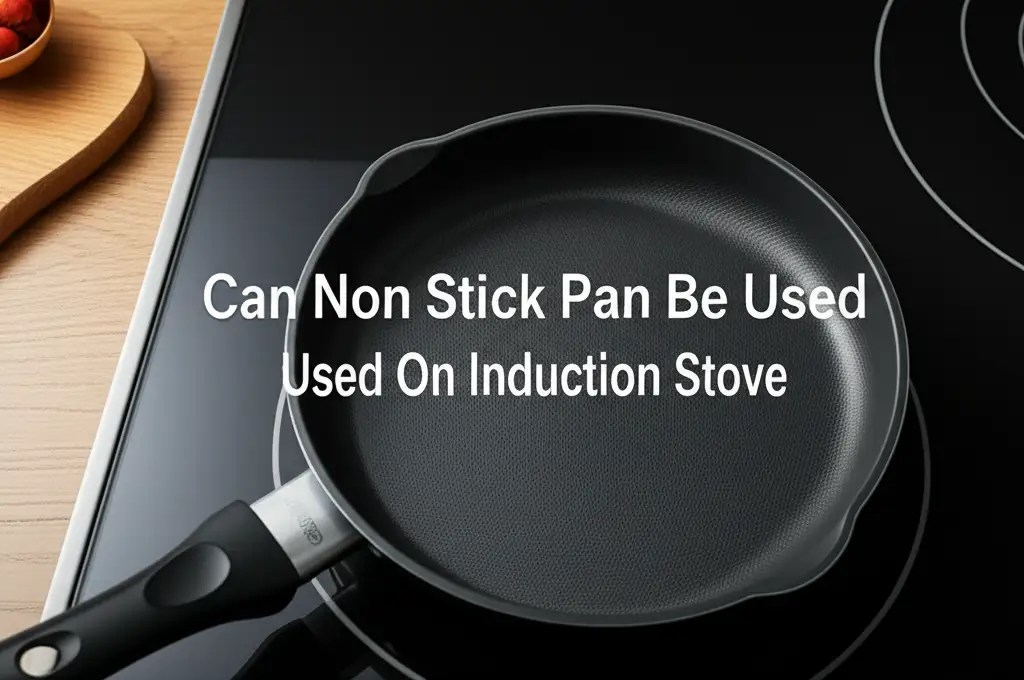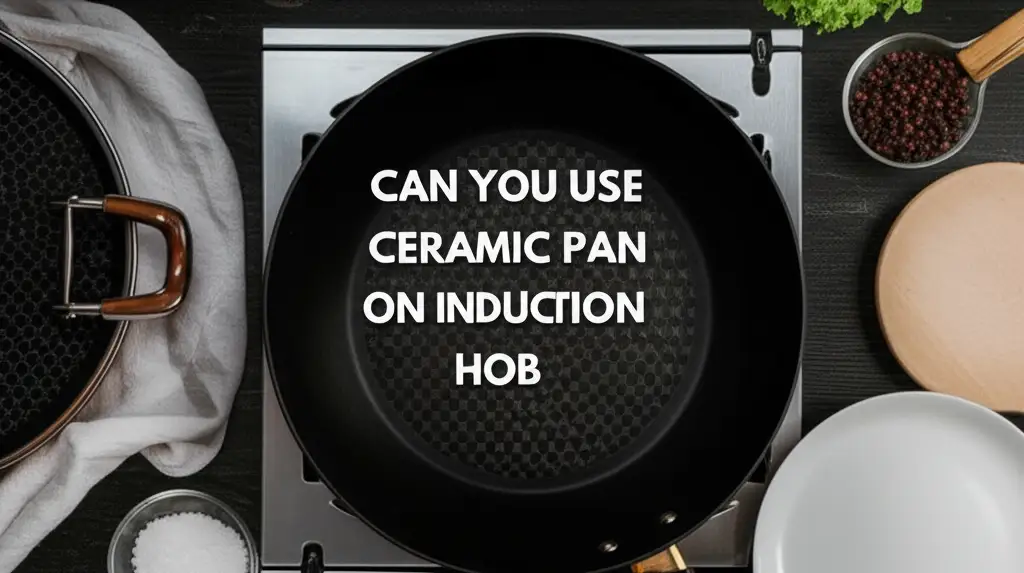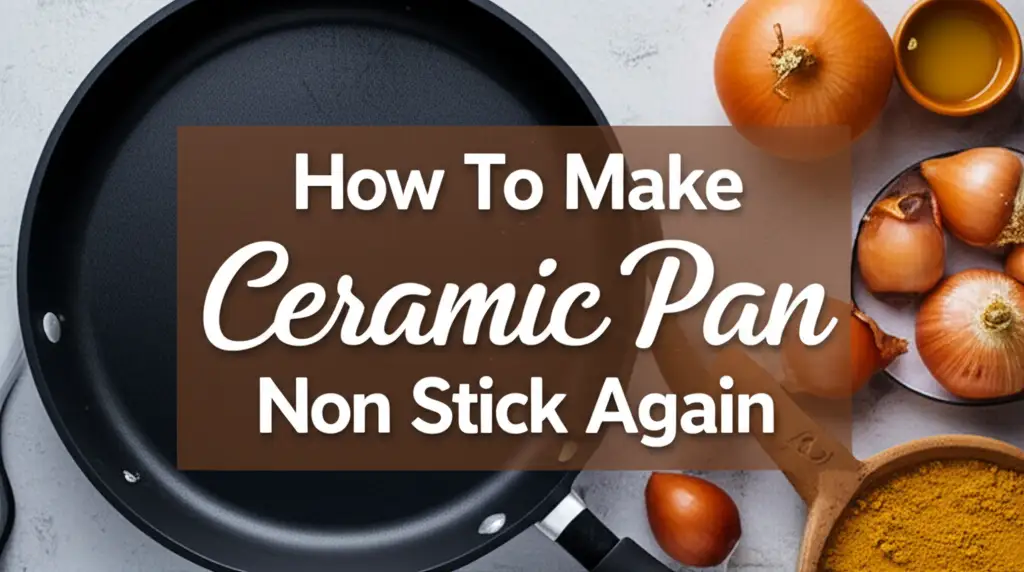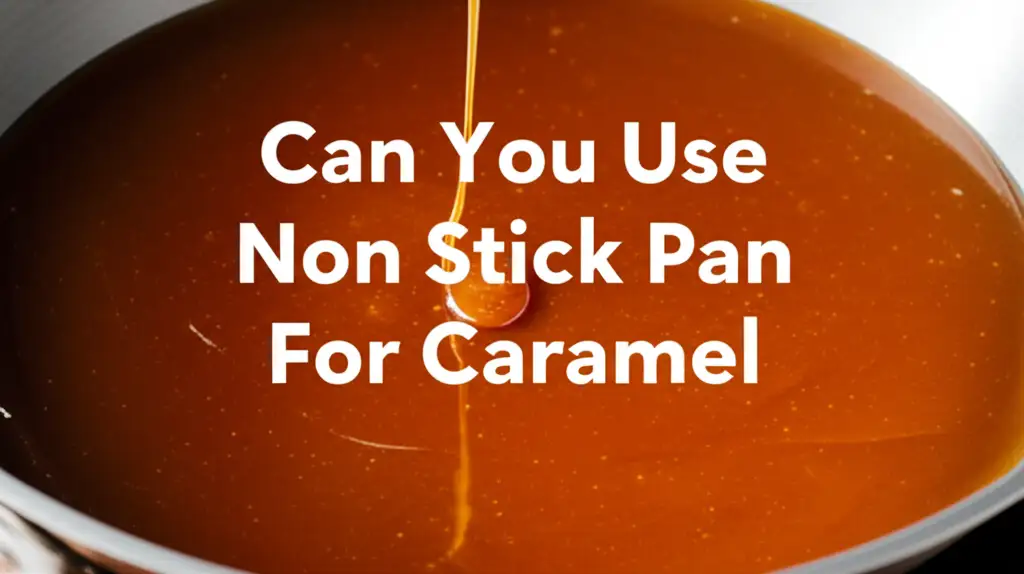· Todd Martin · Kitchen Appliances, Cookware, Induction Cooking · 15 min read
Can I Use Ceramic Pan On Induction Cooktop
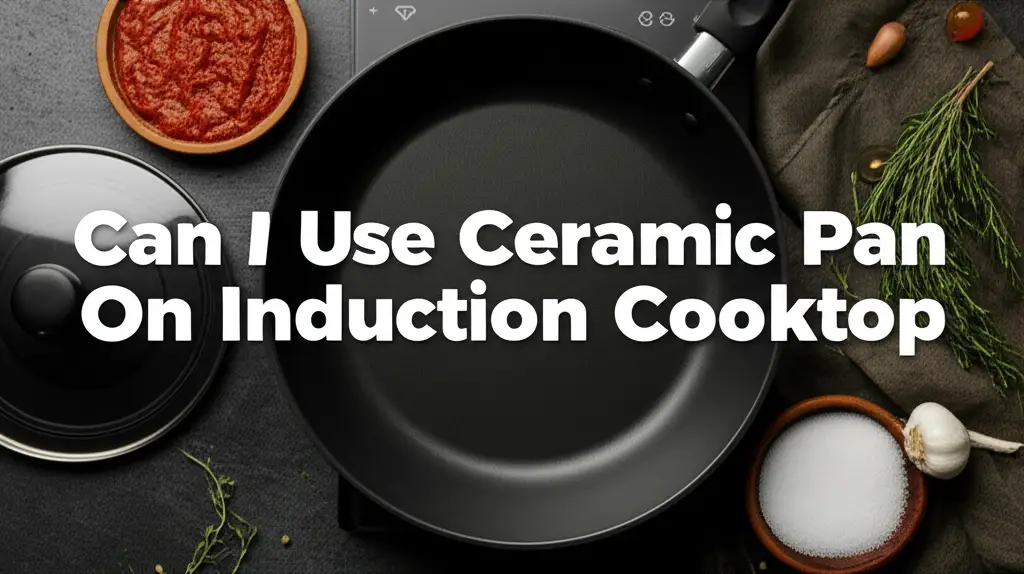
Ceramic Pans & Induction Cooktops: Your Compatibility Guide
Have you ever wondered, “Can I use ceramic pan on induction cooktop?” It is a common question. Many home cooks love ceramic pans for their non-stick surface. Induction cooktops are popular for their speed and energy efficiency. You want to make sure your cookware works with your stove. This article will help you understand if your favorite ceramic pan can work on an induction cooktop. We will cover how induction cooktops operate. We will explain what ceramic pans are made from. Then, we will show you how to check for compatibility. You will learn about the benefits of using the right ceramic cookware. We will also discuss common issues and how to care for your pans. By the end, you will know exactly what to do.
Takeaway
- Check for a Magnetic Base: A ceramic pan must have a magnetic base to work on an induction cooktop.
- Look for the Induction Symbol: Find a coiled wire icon on the pan’s bottom.
- Perform the Magnet Test: If a magnet sticks firmly to the pan’s base, it is induction-compatible.
- Understand Pan Types: Full ceramic pans typically do not work; ceramic-coated pans with a magnetic metal core do.
- Ensure Proper Care: Follow cleaning and usage instructions for longevity.
Can I Use Ceramic Pan On Induction Cooktop?
Yes, you can use a ceramic pan on an induction cooktop, but only if the pan has a magnetic base. Most ceramic pans sold today are ceramic-coated over a magnetic metal like steel or cast iron. True, solid ceramic pans usually do not work because they are not magnetic. Always check for the induction symbol or use a magnet.
Understanding Induction Cooktop Technology
Induction cooktops use a special heating method. They do not use open flames or electric coils. Instead, they use electromagnetism. A coil of copper wire sits under the cooktop’s surface. When you turn the cooktop on, an alternating electric current flows through this coil. This current creates a fluctuating magnetic field. This field is the key to how induction works.
The magnetic field needs specific cookware to create heat. It causes the electrons in the base of a compatible pan to move rapidly. This movement generates heat directly within the pan itself. The cooktop surface stays relatively cool. This direct heating makes induction cooktops very efficient. They heat food quickly. They also respond instantly to temperature changes. This is different from gas or electric stoves.
For a pan to work on an induction cooktop, its base must be ferromagnetic. This means it must be made of a material that magnets stick to. Common examples include cast iron and many types of stainless steel. Aluminum and copper pans are not magnetic. They will not work on induction unless they have a special magnetic layer bonded to their base. You can learn more about using copper pans on induction cooktops here. Knowing this helps you choose the right cookware.
The Nature of Ceramic Pans
When we talk about “ceramic pans,” it is important to know what this means. Most ceramic pans you see in stores are not made entirely of ceramic. They usually have a metal core. This core is often aluminum, stainless steel, or even cast iron. The cooking surface is then coated with a ceramic-based non-stick material. This coating is often made from inorganic minerals. It gives the pan its smooth, non-stick properties.
True, solid ceramic pans do exist. These pans are made from 100% ceramic material. They are very resistant to high temperatures. However, they are also quite brittle. They can break easily if dropped. These solid ceramic pans are not common for everyday stovetop cooking. They are more often used for baking dishes or slow cooking.
The type of base material is crucial for induction cooking. If a ceramic-coated pan has an aluminum base, it will not work on induction. Aluminum is not magnetic. If the base is stainless steel or cast iron, it might work. This is because steel and iron are magnetic metals. The ceramic coating itself does not affect induction compatibility. The base material under the coating is what matters. Understanding this difference helps you make smart choices for your kitchen.
Are Ceramic Pans Induction-Compatible? The Core Question
The simple answer is that some ceramic pans are induction-compatible, and some are not. It all depends on the construction of the pan’s base. An induction cooktop generates heat by creating a magnetic field. This field needs a magnetic material in the pan’s base to work. If your ceramic pan has a base made from a magnetic material, such as cast iron or certain types of stainless steel, it will work. The ceramic non-stick coating itself does not conduct magnetism.
Many ceramic-coated pans have an aluminum core. Aluminum is a lightweight and good heat conductor. However, aluminum is not magnetic. Therefore, an aluminum-based ceramic pan will not heat up on an induction cooktop. These pans are designed for electric or gas stoves. It is a common misconception that all ceramic pans are the same. This is not true.
To tell if your specific ceramic pan is induction-compatible, you need to test it. The most reliable method is the magnet test. If a regular kitchen magnet sticks firmly to the bottom of your pan, it means the pan has a ferromagnetic base. This pan will likely work on an induction cooktop. If the magnet does not stick, or if it only sticks weakly, the pan is not induction-ready. For more details on using ceramic pans on different hobs, you can check this guide: Can You Use Ceramic Pan On Induction Hob. This test helps you avoid frustration in the kitchen.
Identifying Induction-Ready Ceramic Cookware
Knowing if your ceramic pan will work on an induction cooktop is easy. You do not need special tools. There are two main ways to check for compatibility. Both methods are quick and reliable. I always recommend doing both if you are unsure about a pan.
The Magnet Test in Detail
This is the simplest and most effective test. Take a common kitchen magnet, like one you use on your refrigerator. Place the magnet against the bottom of your ceramic pan.
- If the magnet sticks firmly to the pan’s base, your pan is induction-compatible. The magnetic attraction means the pan contains iron or magnetic stainless steel. This material will interact with the induction cooktop’s magnetic field.
- If the magnet does not stick at all, or only sticks very weakly, the pan is not induction-compatible. Its base is likely made of a non-magnetic material, such as aluminum. This pan will not heat up on an induction surface.
This test is your first line of defense. It gives you a clear answer right away.
Looking for the Induction Symbol
Many cookware manufacturers put a special symbol on their induction-compatible products. This symbol is usually on the bottom of the pan. It looks like a coil or a horizontal zigzag. Sometimes, it is combined with the word “Induction.”
- Check the pan’s base: Look for this symbol engraved or printed on the very bottom of the pan.
- Check packaging or product descriptions: If you are buying a new pan, the box or online product page will clearly state “induction compatible” if it is.
Always double-check both the magnet test and the symbol. Sometimes, older pans might not have the symbol, but they are still magnetic. Or a symbol might be present, but the pan’s magnetic properties are weak. Using both checks ensures you have the right information. This helps you cook efficiently and safely.
Benefits of Using Compatible Ceramic Pans on Induction
When you use the right ceramic pan on your induction cooktop, you unlock several advantages. These benefits make cooking more enjoyable and efficient. Many people choose ceramic for specific reasons. I find these reasons compelling for daily use.
First, excellent non-stick properties are a major plus. Ceramic coatings create a very smooth surface. Food slides off easily. This means less oil is needed for cooking. It also makes cleanup much simpler. You can cook delicate foods like eggs or fish without worry of sticking. This feature saves you time and effort after meals.
Second, even heat distribution is a key benefit. Good quality induction-compatible ceramic pans have a thick, flat magnetic base. This base ensures the heat from the induction cooktop spreads evenly across the entire cooking surface. You avoid hot spots that can burn food. This leads to more consistent cooking results. Your pancakes will cook uniformly, and your sauces will simmer perfectly.
Third, these pans are generally healthier options. Many modern ceramic coatings are made without PFOA, PFAS, or lead. These chemicals were sometimes found in older non-stick coatings. Using PFOA/PFAS-free ceramic pans offers peace of mind. You cook with fewer concerns about chemicals leaching into your food.
Fourth, you get the energy efficiency of induction cooking. Induction cooktops heat pans directly. Very little energy is wasted. When you pair this with a good ceramic pan, cooking times are faster. Your kitchen stays cooler because heat is concentrated in the pan, not in the air. This saves energy and keeps your home comfortable.
Finally, ease of cleaning is significant. Thanks to the non-stick surface, most food residue wipes away easily. This reduces scrubbing. It prolongs the life of your pan. You can learn how to clean a ceramic pan with baking soda for stubborn stains. These benefits make compatible ceramic pans a smart choice for any induction kitchen.
Potential Challenges & Solutions
While compatible ceramic pans offer great benefits, you might face some challenges. It is good to know what these are and how to solve them. This prepares you for any issues that arise during cooking. I have encountered a few situations myself that taught me these lessons.
The first challenge is non-compatibility. As we discussed, not all ceramic pans work on induction. If you try to use a non-magnetic ceramic pan, your induction cooktop will simply not heat up. It might display an error message. The solution is simple: always check for magnetic compatibility before buying or using a pan. Use the magnet test or look for the induction symbol. This prevents frustration in the kitchen.
Another potential issue is uneven heating or poor performance with some compatible pans. This can happen if the pan’s magnetic base is too thin or not perfectly flat. A thin base might not absorb enough energy from the magnetic field. This leads to slower heating or hot spots. A warped base prevents full contact with the induction surface. This reduces efficiency. The solution is to invest in good quality induction-ready ceramic pans. Look for pans with thick, encapsulated bases. For general tips on using non-stick pans on induction, this guide might help.
What if My Ceramic Pan Isn’t Magnetic?
If your favorite ceramic pan is not magnetic, you have an option. You can buy an induction diffuser disc. This is a flat metal disc made from ferromagnetic material. You place it on your induction cooktop, and then you put your non-magnetic pan on top of the disc. The diffuser disc heats up on the induction surface. Then, it transfers that heat to your non-magnetic pan through conduction. It works like a traditional burner.
However, using a diffuser disc has drawbacks. It reduces the energy efficiency of your induction cooktop. It also takes longer to heat up. The direct, instant response of induction cooking is lost. It is a good temporary solution for a beloved pan. For regular cooking, I recommend getting a truly induction-compatible pan.
Ensuring Optimal Performance
To get the best results from your induction-compatible ceramic pan:
- Choose quality: Invest in pans with robust, flat magnetic bases.
- Heat gradually: While induction is fast, avoid extreme high heat settings immediately. This can protect the non-stick coating.
- Avoid overheating: Ceramic coatings can degrade with excessive high heat. Know when your ceramic pan is hot enough to cook. This guide can help you understand how to know when your ceramic pan is hot enough.
- Maintain the coating: Use silicone or wooden utensils. Avoid metal tools that can scratch the surface.
By understanding these challenges and applying these solutions, you can enjoy successful cooking with your ceramic pans on an induction cooktop.
Caring for Your Ceramic Pan on an Induction Cooktop
Proper care helps your ceramic pan last longer. It also keeps its non-stick properties effective. Induction cooktops have unique characteristics that influence how you should care for your cookware. Following these tips will ensure your pan performs well for years. I follow these steps for my own ceramic pans.
First, preheat carefully. Induction cooktops heat very quickly. This means a ceramic pan can get hot faster than you expect. Rapid, extreme heating can sometimes damage the non-stick coating over time. Start with medium heat settings. Let the pan warm up for a minute or two. Then, adjust the temperature as needed. Avoid leaving an empty pan on a high induction setting for too long.
Second, avoid thermal shock. Thermal shock happens when a hot pan is suddenly exposed to cold water. This can cause the pan’s base to warp. It can also damage the ceramic coating. Always let your ceramic pan cool down completely before washing it. This is a simple but important rule.
Third, hand washing is best. While some ceramic pans are labeled as dishwasher safe, hand washing extends their life. Use warm, soapy water and a soft sponge or cloth. The non-stick surface makes cleaning easy. Harsh dishwasher detergents and high heat can degrade the ceramic coating over time. If you face issues with food sticking, you might want to learn how to make a ceramic pan non-stick again.
Fourth, use proper utensils. Metal utensils can scratch and damage the delicate ceramic coating. Always use wooden, silicone, or plastic spatulas and spoons. This preserves the non-stick surface. It also prevents small pieces of coating from flaking off into your food.
Fifth, store pans properly. Do not stack pans directly on top of each other without protection. This can scratch the non-stick surface. Place a cloth or felt protector between pans when stacking them. This keeps the coating in good condition.
By following these care instructions, your ceramic pan will continue to perform wonderfully on your induction cooktop. It will serve you well for many meals.
FAQ Section
Q: Can full ceramic pans work on induction?
A: No, full ceramic pans typically do not work on induction cooktops. These pans are made entirely of ceramic material, which is not magnetic. Induction technology requires a pan with a ferromagnetic base. Full ceramic pans usually need a traditional electric or gas stove to heat up.
Q: How do I know if my ceramic pan is induction-ready?
A: You can check in two ways. First, look for an induction symbol on the pan’s bottom. This symbol often looks like a coil. Second, perform a magnet test. If a strong magnet sticks firmly to the pan’s base, it is induction-compatible. If the magnet does not stick, the pan will not work.
Q: What happens if I use a non-induction pan on an induction cooktop?
A: If you place a non-magnetic pan, like a non-induction ceramic pan, on an induction cooktop, nothing will happen. The cooktop will not recognize the pan and will not generate heat. Most induction cooktops will display an error message or simply turn off after a few seconds. No damage occurs to the pan or the cooktop.
Q: Are ceramic pans better than other non-stick pans on induction?
A: “Better” depends on your needs. Ceramic pans offer a non-toxic, non-stick surface. They often provide good heat distribution when induction-compatible. Other non-stick pans, like those with PTFE coatings, also work on induction if they have a magnetic base. Ceramic is a popular choice for those wanting PFOA/PFAS-free options.
Q: Can I use an induction diffuser with my ceramic pan?
A: Yes, you can use an induction diffuser disc with a non-magnetic ceramic pan. Place the diffuser on the induction cooktop, then put your ceramic pan on top of the disc. The disc will heat up and transfer that heat to your pan. Be aware that this method reduces efficiency and heating speed compared to direct induction cooking.
Conclusion
Determining “Can I use ceramic pan on induction cooktop?” comes down to one key factor: magnetism. Ceramic pans are a fantastic addition to any kitchen due to their non-stick benefits and ease of cleaning. However, for them to work effectively on an induction cooktop, they must have a magnetic base. Remember to perform the simple magnet test or look for the induction compatibility symbol on the pan’s bottom. This quick check saves you time and ensures your cooking experience is smooth.
By choosing induction-ready ceramic cookware, you get the best of both worlds. You benefit from the rapid, energy-efficient heating of your induction cooktop. You also enjoy the healthy, easy-release cooking surface of ceramic. If your current ceramic pan is not compatible, consider an induction diffuser disc as a temporary solution, or invest in a new pan designed for induction. Proper care, like gentle preheating and hand washing, will extend the life of your ceramic pan. Embrace smart cooking choices. Enjoy delicious meals with the right ceramic pan on your induction cooktop. Happy cooking!


